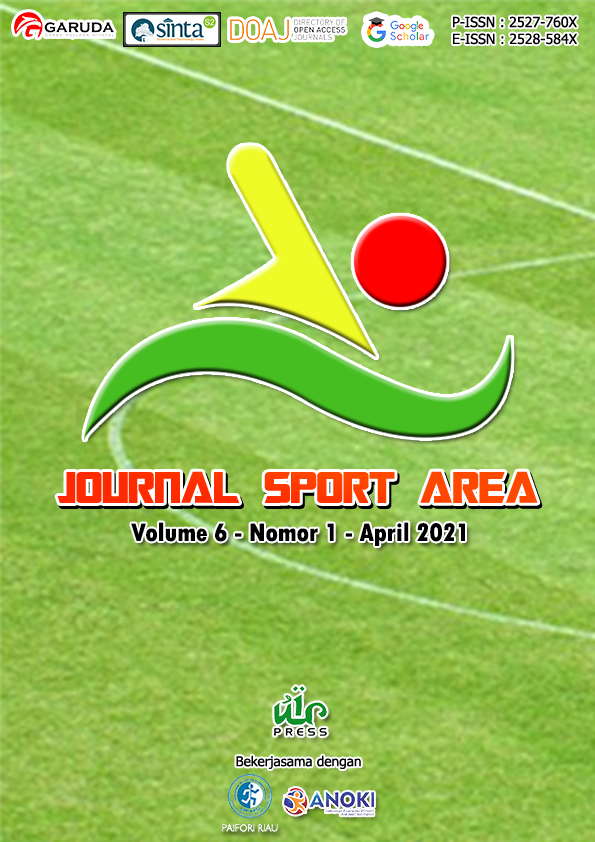Teaching methods and educability motors: Effectiveness in improving long-jump skills
Keywords:
Teaching method, command style, training style, motor educability, long jumpAbstract
This study investigates the differences in exercise teaching methods, commando teaching methods and motor skills on long jump skills. This research is conducted at SMP Negeri 17 Serang, Banten Province. The research design uses a 2 X 2 factorial. A random cluster technique is used in sampling. The number of samples taken is 40 students divided into four groups, each consisting of 10 students who are separated using the Verducci technique. Analysis of Variance (ANOVA) in two ways is used in analyzing the data and continued with the Tukey test with a significance level of a = 0.05, with the results: (1) overall there is a difference in the effect between the training style teaching method and the command style on long jump skills, (2) students who have high motor educability, the exercise style teaching method is better than the command style teaching method for long jump skills, (3) there is no significant difference in students who have low motor ability to the command style teaching method with the exercise style teaching method learning outcomes long jump skills, (4) there is a positive interaction between teaching methods and motor skills for long jump skills. This research needs to be followed up in the future to provide input to teachers and researchers. If you want to measure the motor ability of long jump learning, you can use the training teaching method to get maximum results.
Downloads
References
Agam, G. A., Rahayu, S., & Rifai, A. (2016). Pengaruh gaya mengajar guided discovery dan tingkat motor educability terhadap hasil belajar pencak silat. Journal of Physical Education and Sports, 5(2), 134–139. https://doi.org/10.15294/JPES.V5I2.13452
Andriani, R., & Rasto, R. (2019). Motivasi belajar sebagai determinan hasil belajar siswa. Jurnal Pendidikan Manajemen Perkantoran, 4(1), 128-135. https://doi.org/10.17509/jpm.v4i1.14958
Aryanti, N. E. (2019). Studi korelasional antara motor educability, feedback, dan percaya diri dengan keterampilan dribbling instep of the foot siswa putra ekstrakurikuler sepakbola SMPN 29 Jakarta Tahun 2013. Jurnal Ilmiah Sport Coaching and Education, 3(1), 51–64.
Candra, R. D., & Hidayah, T. (2015). Pengaruh metode latihan dan kemampuan motor educability terhadap hasil latihan teknik dasar sepakbola. Journal of Physical Education and Sports, 4(2). 159-164. https://doi.org/10.15294/JPES.V4I2.9888
Fallo, H. I. S. (2016). Upaya meningkatkan keterampilan smash permainan bola voli melalui pembelajaran gaya komando. Jurnal Pendidikan Olah Raga, 5(1), 10–19.
Huda, D. (2012). Sumbangan kecepatan, berat badan, daya ledak terhadap lompat jauh. JSSF (Journal of Sport Science and Fitness), 1(1), 1–6. https://doi.org/10.15294/JSSF.V1I1.212
Imansyah, F. (2019). Pengaruh metode inklusi menggunakan media pembelajaran dan tingkat motor educability terhadap hasil keterampilan belajar renang gaya dada pada mahasiswa jurusan pendidikan olahraga. Seminar Nasional Olahraga. Universitas PGRI Palembang.
Iswandi, F., Kaswari, K., & Purnomo, E. (2013). Hubungan sprint dan daya ledak otot tungkai terhadap hasil lompat jauh gaya jongkok. Jurnal Pendidikan dan Pembelajaran Khatulistiwa, 2(4), 1-10.
Juniar, D. T., & Iskandar, T. (2018). Pengaruh gaya mengajar komando dan motor ability rendah terhadap hasil belajar tendangan dolyo chagi taekwondo. JOSSAE : Journal of Sport Science and Education, 2(2), 42. https://doi.org/10.26740/jossae.v2n2.p42-45
Nurhasan, H., & Hasanudin, C. D. (2014). Modul tes dan pengukuran keolahragaan. Bandung: Fakultas Pendidikan Olahraga dan Kesehatan UPI.
Paturusi, A. (2012). Manajemen pendidikan jasmani dan olahraga. Jakarta: Rineka Cipta.
Putra, H. B., Asim, A., & Hariyanto, E. (2017). Perbedaan pengaruh gaya mengajar komando dengan gaya mengajar latihan terhadap minat peserta didik pada pembelajaran permainan bola voli kelas X Madrasah. Gelanggang Pendidikan Jasmani Indonesia, 1(2), 252–261. http://dx.doi.org/10.17977/um040v1i2p252-261
Rahayu, E. T. (2013). Strategi pembelajaran pendidikan jasmani. Bandung: Alfabeta.
Rahayu, P., Rahayu, T., & RC, A. R. (2017). Pengaruh gaya mengajar latihan dan koordinasi mata tangan terhadap hasil pembelajaran dribbling bola basket. Journal of Physical Education and Sports, 6(2), 186–192. http://dx.doi.org/10.15294/JPES.V6I2.17394
Rizal, B. T., & Kasriman, K. (2020). Pengaruh gaya mengajar dan koordinasi mata tangan terhadap keterampilan smash bola voli. Jurnal MAENPO: Jurnal Pendidikan Jasmani Kesehatan dan Rekreasi, 10(2), 72–83. https://doi.org/10.35194/jm.v10i2.1065
Sujana, R., Muhtar, T., & Nuryadi. (2014). Pengaruh pendekatan pembelajaran dan motor educability terhadap hasil belajar teknik dasar dan keterampilan bermain sepakbola. Edusentris, 1(3), 260–274. https://doi.org/10.17509/edusentris.v1i3.150
Sumantri, R. J., Sulaiman, S., & Nasuka, N. (2016). Pengaruh media gaya mengajar latihan dan tingkat motor educability terhadap hasil belajar pencak silat. Journal of Physical Education and Sports, 5(2), 127–133. https://doi.org/10.15294/JPES.V5I2.13449
Sutikno, S. (2014). Metode dan Model-model Pembelajaran. Lombok: Holistica.
Syahruddin, S., & Suyuti, A. (2016). Pengaruh gaya mengajar latihan dan gaya mengajar komando terhadap keterampilan passing atas bola voli. Jurnal Pedagogik Olahraga, 2(1), 11–22. https://doi.org/10.22245/jpor.v2i1.4505
Zulkifli., Yani, A., Kamarudin., Sasmarianto., Alficandra., & Henjilito, R. (2020). Pengaruh dua gaya mengajar mosston dan dukungan motor ability mahasiswa terhadap hasil belajar teknik dasar sepak takraw. Journal Sport Area, 5(1), 51–64. https://doi.org/10.25299/sportarea.2020.vol5(1).4693
Published
How to Cite
Issue
Section
This is an open-access article distributed under the terms of the Creative Commons Attribution-ShareAlike 4.0 International License which permits unrestricted use, distribution, and reproduction in any medium. Copyrights of all materials published in Journal Sport Area are freely available without charge to users or / institution. Users are allowed to read, download, copy, distribute, search, or link to full-text articles in this journal without asking by giving appropriate credit, provide a link to the license, and indicate if changes were made. All of the remix, transform, or build upon the material must distribute the contributions under the same license as the original.
Accepted 2021-01-19
Published 2021-02-09












